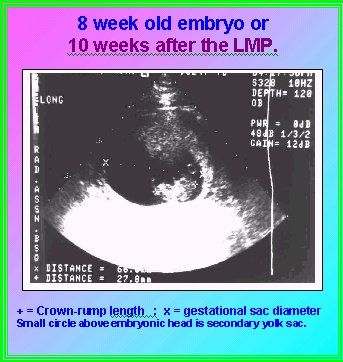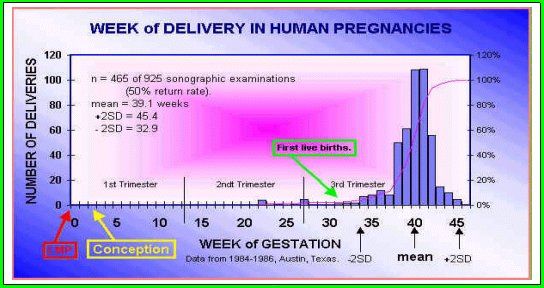An Educational Short Story: Menstrual Cycles, Pregnancy, and Confusion
The following story is a composite of many situations I have witnessed in twenty-two years as a Diagnostic Medical Sonographer.The names and events are fictitious; but similar situations often arise.
The following story is a composite of many situations I have witnessed in twenty-two years as a Diagnostic Medical Sonographer.
The names and events are fictitious; but similar situations often arise.
Jane excitedly dialed the phone. She was calling John, her husband, at work. She is a computer program analyst for a consulting company. John is an aeronautical engineer. They had been married for five years. Jane just learned that she is pregnant.
John answered his cell-phone from the plant floor. Jane blurted out; “We’re pregnant!” John stopped short; he focused totally on Jane’s voice… holding his breath. Then he breathed out, almost in a whisper, “Wonderful”. They had been hoping and trying to have a baby for over a year now. Both were in their mid-thirties and were anxious to start their family.
He asked, “When is it due?”

Jane responded, “February 15th, it could be on Valentine’s Day! Jackie said Joe, the sonographer, had estimated the gestational age to be ten weeks by ultrasound measurements. Everything is fine and I have a picture of our baby!” Jackie was the OB/Gyn physician that Jane had been seeing through her company health care provider.
John said, “I’ll leave early. Let’s celebrate! I love you.” “I love you, too.” Jane responded.
John started back to his office, a spring in his step. He was aware of feeling good. He thought as he walked, “Ten weeks…. Today is July 23 and the baby is ten weeks old. I wonder how big it is now? Two and a half months…” John stopped in his tracks. And blurted aloud to himself, “I was in Belgium!” The aircraft manufacturer had a plant in Belgium, and he had spent the entire month of May there helping to set up an assembly line for a new aircraft contract. Then John told himself, “The date is probably a rough estimate.” Still, it troubled him; Jane usually paid attention to details.
When he got home, Jane was waiting at the door. She was beaming as she handed him the sonograph, but sensed that John was disturbed. She asked, “Aren’t you happy about it?”
John looked at her and asked, “Are they sure about how far along you are?” Jane responded, “Jackie said that this early the gestational age should be very accurate, 10 gestational weeks, why?”
John said, “That means you got pregnant in the middle of May - the month I was in Belgium.” Jane was disturbed as she said, “John, you know I am faithful to you.” John said “Of course I believe you. It disturbs me, could there be something wrong? Could there be a problem with the baby’s size or growth.”
Jane: “Come on, let’s call Jackie.” She turned toward the phone, picked it up, dialed. The HMO’s receptionist answered, the call was transferred to the obstetrical group. Jane asked to talk to Dr. Jackie Hamilton. The voice at the other end said, “She can’t come to the phone now.” Jane responded, “I need to speak with Dr. Hamilton. We have a concern about the dates of our pregnancy. Please ask her to call us as soon as she can.”
The receptionist said, “I’ll have Dr. Hamilton call as soon as she comes out of the exam room.” Jane and John sat by the phone. Jane took a breath, “Jackie said the sonographer estimated me to be ten gestational weeks.”
John asked, “Gestational weeks, what exactly does that mean?” Jane responded, “I think it means how long I’ve been pregnant.” John said, “Well that’s impossible, right?” Jane agreed. John stood up and got the dictionary. He looked up “gestation”. He read aloud, “Gestation: the period of carrying developing offspring in the uterus after conception: pregnancy.” As he looked up at Jane the phone rang. It was the obstetrician.
Jane explained why she couldn’t be 10 weeks pregnant. After a bit of confusion, Jackie said, “Oh, I see why you are confused. Gestational age doesn’t mean the time from conception. It is the time from your last menstrual period.” Jane asked, “What?” Jackie, “Well, it is just a convention. In medicine we date pregnancies from the mother’s last menstrual period because we usually don’t know exactly when conception takes place.” Continuing, Jackie said, “According to what you told me your last menstrual period started on May 13th, today is July 23rd, so you probably conceived about the 28th of May, give or take a day or two.. You are right on time.”
Jane queried, “But you said gestational age?” Jackie responded, “It is just medical jargon. When we say gestational age we are really adding two weeks to the conceptual age and dating the pregnancy from the last menstrual period. We just call it the gestational age. Conception really takes place about two weeks later, right after you ovulate. When did John come back from Belgium?”
Jane turned to John, “When did you get back from Europe?” John, looking at his calendar, “The end of May… May 28th.” Jane repeated the date into the phone. Jackie, chuckled, “I’ll bet you conceived the night he got back to town!”
Jane’s reaction surprised the doctor. “Why do you medical people insist on using terminology that no one else can understand? The dictionary says gestation is the period of time in the uterus, not the time from the last menstrual period!” Jackie could tell Jane was upset. She said, “I’m not sure. It probably goes back to whenever people figured out what caused pregnancy. The LMP, I mean last menstrual period, is often the only empirical date that we have. I’m sorry for the confusion. Do you want to come in and discuss it further? I have an embryology book here that shows the progression of pregnancy in detail.”
Jane was calmer. She said, “No, I’ll just keep my next appointment, but would you please explain the dates to John? This was sort of confusing, I want him to understand.”
The rest of Jane’s pregnancy proceeded normally. On Valentine’s day Jane delivered a healthy six pound five ounce girl. They named her Jill.
Comment:
This short story is here in the hopes that it will make understanding the dates of menstrual cycles and pregnancies easier to follow. For more specific information the following discussion is provided.
This is a fictional scenario that is based on many encounters with similar patient confusion during a career in sonography. I do not understand why the medical profession continues to refer to the fetal age in pregnancy as the “gestational age” when in reality the dates are calculated from the last menstrual period, usually referred to as the LMP. The normal menses starts every twenty-eight days, but some women vary from this cycle a little. The normal human gestation is about 266 days (38 weeks), with the additional two weeks (14 days) from the LMP making the normal period from the LMP to delivery 40 weeks or 280 days.
After ovulation, which normally occurs 14 days after the LMP, fertilization takes place in the fallopian tube a day or so after ovulation. The fertilized egg begins cell division (mitosis), is then called a morula, and travels down the tube and finally implants in the uterus as a Blastocyst (a mass of cells). Implantation normally takes place about three days after fertilization, but there is some variation in these times.

There is actually about a five-day window of time in which implantation in the uterus takes place following ovulation and fertilization. Every woman does not have menstrual cycles that are exactly twenty-eight days long, so that is another variable. All this variation makes the use of the LMP to date pregnancy very unreliable. In fact a recent editorial in the international journal of Obstetrics and Gynecology in Ultrasound actually proposed that we forget about the LMP as far as dating pregnancies. Considering the scenario above, that might be a good idea. Sonographic dates are more accurate than the LMP for predicting the dates of a pregnancy.
With sonographic measurements of the embryo and fetus, we can now estimate the date of implantation more accurately than we can the expected birth date or Estimated Date of Confinement (EDC, another one of those old medical phrases). Sonographic age estimates are not perfect either and will vary by about +/- 10% of the age; i.e. they are less accurate later in pregnancy. Pregnancies also vary in length. The following is a bar graph or histogram of 465 pregnancies as dated by sonographic measurements. The sonographic dates were adjusted to correspond to the LMP weeks. These dates are much more uniform than the same data using LMP dates would be. This makes it much easier to see the variation in the birth dates.

As you can observe from the above graph, most people deliver between 38 and 42 weeks after the LMP, with an average time of approximately 40 weeks. The reason the mean (39.1 weeks) in this population is less than the accepted standard (40 weeks) is this graph includes all pregnancies, abnormal as well as normal deliveries. This reduced the average ages. There were four still born. The small peak after 35 weeks includes several Cesarean Sections and induced labors.
S1E4: Dr. Kristina Adams-Waldorf: Pandemics, pathogens and perseverance
July 16th 2020This episode of Pap Talk by Contemporary OB/GYN features an interview with Dr. Kristina Adams-Waldorf, Professor in the Department of Obstetrics and Gynecology and Adjunct Professor in Global Health at the University of Washington (UW) School of Medicine in Seattle.
Listen
Study shows a healthy prenatal diet could be upstream obesity prevention strategy
December 26th 2024"Our findings support the recommendation of a healthy diet based on the current guidelines (as measured by the HEI) during pregnancy, since it may reduce patterns of infant growth outside reference ranges."
Read More
Early pregnancy cannabis use high in states with recreational legalization
November 11th 2024A population-based time-series analysis California before, during and after legalization show a rising trend in women using cannabis while pregnancy especially when the state has legalized the drug.
Read More
